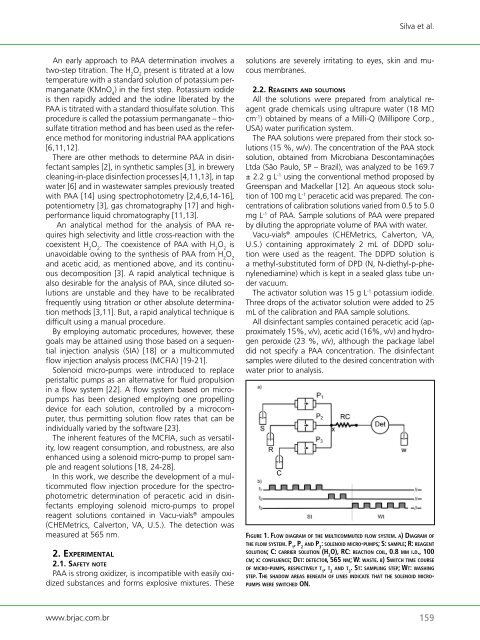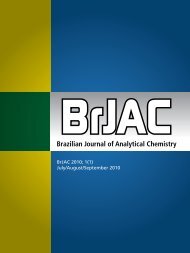Brazilian Journal of Analytical Chemistry - BRJAC - Brazilian Journal ...
Brazilian Journal of Analytical Chemistry - BRJAC - Brazilian Journal ...
Brazilian Journal of Analytical Chemistry - BRJAC - Brazilian Journal ...
Create successful ePaper yourself
Turn your PDF publications into a flip-book with our unique Google optimized e-Paper software.
An early approach to PAA determination involves a<br />
two-step titration. The H 2 O 2 present is titrated at a low<br />
temperature with a standard solution <strong>of</strong> potassium permanganate<br />
(KMnO 4 ) in the first step. Potassium iodide<br />
is then rapidly added and the iodine liberated by the<br />
PAA is titrated with a standard thiosulfate solution. This<br />
procedure is called the potassium permanganate – thiosulfate<br />
titration method and has been used as the reference<br />
method for monitoring industrial PAA applications<br />
[6,11,12].<br />
There are other methods to determine PAA in disinfectant<br />
samples [2], in synthetic samples [3], in brewery<br />
cleaning-in-place disinfection processes [4,11,13], in tap<br />
water [6] and in wastewater samples previously treated<br />
with PAA [14] using spectrophotometry [2,4,6,14-16],<br />
potentiometry [3], gas chromatography [17] and highperformance<br />
liquid chromatography [11,13].<br />
An analytical method for the analysis <strong>of</strong> PAA requires<br />
high selectivity and little cross-reaction with the<br />
coexistent H 2 O 2 . The coexistence <strong>of</strong> PAA with H 2 O 2 is<br />
unavoidable owing to the synthesis <strong>of</strong> PAA from H 2 O 2<br />
and acetic acid, as mentioned above, and its continuous<br />
decomposition [3]. A rapid analytical technique is<br />
also desirable for the analysis <strong>of</strong> PAA, since diluted solutions<br />
are unstable and they have to be recalibrated<br />
frequently using titration or other absolute determination<br />
methods [3,11]. But, a rapid analytical technique is<br />
difficult using a manual procedure.<br />
By employing automatic procedures, however, these<br />
goals may be attained using those based on a sequential<br />
injection analysis (SIA) [18] or a multicommuted<br />
flow injection analysis process (MCFIA) [19-21].<br />
Solenoid micro-pumps were introduced to replace<br />
peristaltic pumps as an alternative for fluid propulsion<br />
in a flow system [22]. A flow system based on micropumps<br />
has been designed employing one propelling<br />
device for each solution, controlled by a microcomputer,<br />
thus permitting solution flow rates that can be<br />
individually varied by the s<strong>of</strong>tware [23].<br />
The inherent features <strong>of</strong> the MCFIA, such as versatility,<br />
low reagent consumption, and robustness, are also<br />
enhanced using a solenoid micro-pump to propel sample<br />
and reagent solutions [18, 24-28].<br />
In this work, we describe the development <strong>of</strong> a multicommuted<br />
flow injection procedure for the spectrophotometric<br />
determination <strong>of</strong> peracetic acid in disinfectants<br />
employing solenoid micro-pumps to propel<br />
reagent solutions contained in Vacu-vials ® ampoules<br />
(CHEMetrics, Calverton, VA, U.S.). The detection was<br />
measured at 565 nm.<br />
2. experImental<br />
2.1. safety n o t e<br />
PAA is strong oxidizer, is incompatible with easily oxidized<br />
substances and forms explosive mixtures. These<br />
www.brjac.com.br<br />
Silva et al.<br />
solutions are severely irritating to eyes, skin and mucous<br />
membranes.<br />
2.2. re a g e n t s a n d s o l u t Io n s<br />
All the solutions were prepared from analytical reagent<br />
grade chemicals using ultrapure water (18 MΩ<br />
cm -1 ) obtained by means <strong>of</strong> a Milli-Q (Millipore Corp.,<br />
USA) water purification system.<br />
The PAA solutions were prepared from their stock solutions<br />
(15 %, w/v). The concentration <strong>of</strong> the PAA stock<br />
solution, obtained from Microbiana Descontaminações<br />
Ltda (São Paulo, SP – Brazil), was analyzed to be 169.7<br />
± 2.2 g L -1 using the conventional method proposed by<br />
Greenspan and Mackellar [12]. An aqueous stock solution<br />
<strong>of</strong> 100 mg L -1 peracetic acid was prepared. The concentrations<br />
<strong>of</strong> calibration solutions varied from 0.5 to 5.0<br />
mg L -1 <strong>of</strong> PAA. Sample solutions <strong>of</strong> PAA were prepared<br />
by diluting the appropriate volume <strong>of</strong> PAA with water.<br />
Vacu-vials ® ampoules (CHEMetrics, Calverton, VA,<br />
U.S.) containing approximately 2 mL <strong>of</strong> DDPD solution<br />
were used as the reagent. The DDPD solution is<br />
a methyl-substituted form <strong>of</strong> DPD (N, N-diethyl-p-phenylenediamine)<br />
which is kept in a sealed glass tube under<br />
vacuum.<br />
The activator solution was 15 g L -1 potassium iodide.<br />
Three drops <strong>of</strong> the activator solution were added to 25<br />
mL <strong>of</strong> the calibration and PAA sample solutions.<br />
All disinfectant samples contained peracetic acid (approximately<br />
15%, v/v), acetic acid (16%, v/v) and hydrogen<br />
peroxide (23 %, v/v), although the package label<br />
did not specify a PAA concentration. The disinfectant<br />
samples were diluted to the desired concentration with<br />
water prior to analysis.<br />
fi g u rE 1. fl o w diagram o f thE m u l t iC o m m u t E d f l o w systEm. a) diagram o f<br />
thE f l o w systEm. P 1 , P 2 a n d P 3 : s o l E n o i d m iC r o-PumPs; s: s a m P l E; r: rE a g E n t<br />
s o l u t i o n; C: CarriEr s o l u t i o n (h 2 o), rC: rE a C t i o n C o i l, 0.8 m m i.d., 100<br />
Cm; x: C o n f l u E n C E; dEt: dEtECtor, 565 n m; w: w a s t E. B) sw i tC h t i mE C o u rs E<br />
o f m iC r o-PumPs, rEsPECtivEly t 1 , t 2 a n d t 3 . st: s a m P l i n g stEP; wt: washing<br />
stEP. thE shadow arEas BEnEath o f l i nE s indiCatE that thE s o l E n o i d m iC r o-<br />
PumPs w E r E switChEd on.<br />
159



